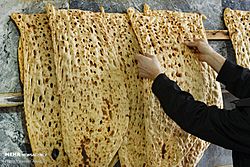Sangak facts for kids

Sangak flatbreads
|
|
| Alternative names | Nan-e sangak |
|---|---|
| Type | Flatbread |
| Place of origin | |
| Region or state | Khorasan |
| Main ingredients | Wheat flour, Sour dough |
| Other information | National bread of Iran |
Sangak (Persian: سنگک, Azerbaijani: səngək, Kurdish: sengek) or nân-e sangak (Persian: نان سنگک) is a special kind of Iranian flatbread. It is made from whole wheat and has a unique rectangular or triangular shape. This bread is a very popular food in Iran.
History of Sangak Bread
In the Persian language, the word 'sangak' means "little stone." This bread gets its name because it is baked on a bed of small, hot river stones inside a special oven. Imagine a baker spreading dough over many small, warm stones!
You can usually find two main types of Sangak bread at bakeries. One type is plain and has no toppings. The other type is a bit more expensive because it has yummy toppings like poppy seeds or sesame seeds. Sometimes it has both!
Sangak and the Persian Army
Sangak bread has a very long history. It was first written about in the 11th century, which is over 900 years ago! This bread was traditionally the food of the ancient Persian army.
Each soldier would carry a small number of pebbles with them. When the army stopped to set up camp, all the soldiers would put their pebbles together. This created a simple "sangak oven" that could bake bread for the entire army. Soldiers often ate this bread with lamb kabab.
Sangak in Different Countries
Sangak bread was also very popular in the area that is now Azerbaijan. However, after the Soviet government took over in 1920, Sangak became less common there. The Soviets preferred making bread in large factories, which did not work well for traditional Sangak, which is usually made by hand.
But in neighboring Iran, Sangak never lost its popularity. It is still a favorite bread today and a very important part of Iranian food culture.
See also
 In Spanish: Sangak para niños
In Spanish: Sangak para niños


